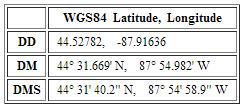
Geographic coordinate systems use a pair of angular measurements to define the location of each point on the surface of the three-dimensional earth. A GCS coordinate pair consists of a latitude (an angle that contributes the north-south part of the location) and a longitude (an angle that contributes the east-west part of the location). The table at right defines the location of a well-known survey marker on the UW-Green Bay campus. Each of the table’s three rows employs a different system of notation (so of course the numeric values differ from one-another), but each defines the marker’s location in a way that is mathematically valid. Geotech professionals need to be fluent in all three notations.
DM and DMS Notations Are Becoming Less Prevalent
The DM and DMS notations are the traditional standard for defining location. Folks who’ve grown up with the legacy notations find them simple and intuitive and often don’t realize they are using a base-60 number system invented by the ancient Babylonians to record fractional values. But the base-60 approach presents a learning challenge to geotech newbies and even perfectly formatted data can’t be plugged in to a computer as-is. The DD (Decimal Degree) notation, on the other hand, utilizes the base-10 number system we learned in grade school. People and computers appreciate not having to divide by 60 (or 3600) to know what is being said about location. These advantages have resulted in a strong push to make DD the universal standard. In our work, we use DD for logging new data and the first thing we do when we encounter DM or DMS data is convert it to DD. There are a gazillion ways to do the conversion. Setting it up as a set of formulas in Excel is nice because you can really see what’s going on.
DM and DMS Notations Will Continue to be Used
The fact that DD is the preferred notation doesn’t mean that DM and DMS will go away completely:
- There’s a cohort of seasoned professionals out there who routinely use DM and/or DMS notation in their work.
- From the standpoint of clarity and accuracy, a DM or DMS coordinate pair is as robust as a DD pair.
- DM and/or DMS notation are taught in some science and technical programs
- DM and/or DMS notation are mandated for some classes of legal documents
| Notes: We recently ran across a technical article that used the term “Degree Decimal Minute” (abbreviated “DDM”) to refer to the notation we call “Degree Minute” in the above paragraphs. |

Comments are closed.